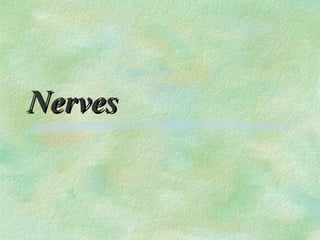Nerves transmit electrical signals through action potentials along axons. Action potentials are generated when a threshold level of depolarization is reached due to voltage-gated sodium channels opening. They then propagate along axons through continued depolarization and repolarization of membrane potentials. At synapses, neurotransmitters are released by presynaptic neurons and bind to receptors on postsynaptic neurons, generating excitatory or inhibitory postsynaptic potentials which can summate to influence firing. Neurons communicate through complex circuits using these synaptic potentials for parallel and serial processing of information.




























































